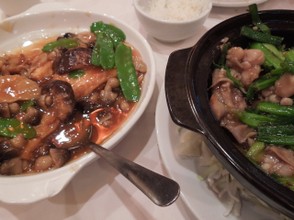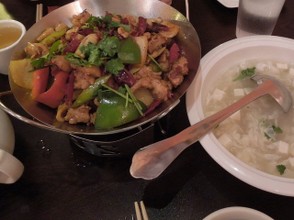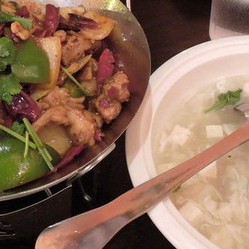Most Chinese restaurants in the U.S. serve Americanized Chinese food. Many only serve such food. Even in restaurants with a fully Americanized menu, however, it is common for chefs to be Chinese and know how to cook a wide range of traditional Chinese dishes. It is also common for restaurants to serve both traditional and Americanized food.
Some restaurants even have a "Chinese menu", which may be written only in Chinese, or also in English, which which lists more traditional foods.
When choosing a restaurant, some things to look for:
- Specials written on a board in Chinese - this is a sign that Chinese people frequent the establishment, and is an almost sure sign that the restaurant is capable of cooking authentic cuisine.
- Items on the menu that are not part of Americanized Chinese fare - examples would be meats like frog, rabbit, or sea cucumber, or dishes that expressly specify "chinese broccoli" (not "Chinese vegetables" as this is part of Americanized lingo). Other examples include dim sum items like shu mai or steamed buns, sticky rice, or casseroles, dishes including seaweed, watercress, or anything that looks completely unfamiliar and can't be found on the generic take-out menus all across America.
- Menus with an "Americanized" section - restaurants focusing on authentic or traditional cuisine often relegate Americanized food to a special section of the menu. If you see such a section on the menu, you know you've found an authentic place to dine--and you can conveniently avoid this section of the menu, or order from it consciously, knowing what you're getting.
- A restaurant that advertises a separate Chinese menu - If you don't see a menu listed, you can ask.
Another tip...ask some of your Chinese friends, if you have any.
Keep in mind that even if you're at a generic Chinese take-out place, there may be a few more traditional items on the menu. Learn how to locate and identify these items, and you'll be able to enjoy this type of food just about anywhere.






 The Shaming of Femininity and Elevation of Masculinityon 07/13/2017
The Shaming of Femininity and Elevation of Masculinityon 07/13/2017
 What is Genderqueer or Non-Binary Gender?on 10/16/2015
What is Genderqueer or Non-Binary Gender?on 10/16/2015
 Resources for Learning Spanish Free Onlineon 04/13/2016
Resources for Learning Spanish Free Onlineon 04/13/2016
 Ways Native Plants Can Help Control Invasive Plantson 05/26/2016
Ways Native Plants Can Help Control Invasive Plantson 05/26/2016


Questions? Comments? Feedback?
Awesome article! Reading through it, I've come to the realization that I've never had authentic Chinese food!
We had one place here that used to serve Manderine (not certain of the spelling) and then they closed. Now, we do have some other good places to eat, but they often cross several styles, and even cross into Vietnamese. My favorite is Won Ton soup. Most can handle this, but not all equally well.
I had the privilege of working with someone from Malaysia who taught me the difference in Western Chinese food and traditional Chinese cuisine. I must say I prefer the traditional food way better. The other difference is the type of spices they use. Most western Chinese restaurants use MSG, whereas, tradition Chinese food has none whatsoever.
Thanks for this, it's really interesting. We have a similar thing in London (for American read "Anglicised"). There are some authentic restaurants about, but some of it is also about how authentic we westerners want our food to be.
Never really thought this through, I never really liked most Chinese food, and I see why now - I wan't get the real thing.
This is one of my pet peeves. I hate when I go in a restaurant and order something and it's the Americanized version.
Thanks John for contributing more info on thees local dishes! I really appreciate it!
There are a few dishes in China that have sugar. In Fu JIan Province where I lived for 3 years, and where I frequently return, they have a local favorite dish called Li Zhi Rou. This is little squares of pork and potato that get covered with sweet potato powder and each fried separately. Then these are stir fried with some onions and peppers with a finishing touch of ketchup to get the red color of the sauce, Chinese ketchup is very sweet. Another favorite dish in this province is fried slices of Yu Tou, "Taro", that have honey added at the end of the frying. Liao Ning Province also has an egg plant dish that is served with a very hot melted sugar coating. However, you are correct that most traditional dishes don't have as much sugar as Western dishes. They also tend to never use tomatoes in a sauce like for Italian dishes. Many of the spicy sour dishes will have sugar added as well.
Yes! Northern Square, also called Yang Yang Express or Dumpling House. It's on Fairfield Ave. between Garrett Rd and Bywood Ave, easily walkable from the 69th street terminal!
You found a liaoning place in upper darby? Don't leave me hanging - which one is it?